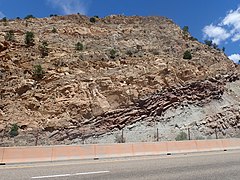Santa Rosa Formation, New Mexico
| Santa Rosa Formation | |
|---|---|
| Stratigraphic range: | |
 Santa Rosa Formation along I-25 in Glorieta Pass. | |
| Type | Formation |
| Sub-units | Tecolotito Member, Los Esteros Member, Tres Lagunas Member |
| Underlies | Garita Creek Formation |
| Overlies | Anton Chico Formation |
| Thickness | 32 meters (105 ft) |
| Lithology | |
| Primary | Sandstone, mudstone |
| Other | Conglomerate |
| Location | |
| Coordinates | 34°57′43″N 104°41′25″W / 34.9620°N 104.6902°W |
| Region | New Mexico, Texas |
| Country | United States |
| Type section | |
| Named for | Santa Rosa, New Mexico |
| Named by | N.H. Dalton |
| Year defined | 1919 |
The Santa Rosa Formation is a geologic formation exposed in New Mexico that was deposited in the Carnian Age of the late Triassic Period.[1]
Description
[edit]The formation consists mostly of white to brown sandstone and mudstone with some interbedded conglomerate. The formation lies on the Anton Chico Formation[1] and is overlain by the Garita Creek Formation.[2] The total thickness of the formation is 32 meters (105 ft).[1]
The formation is divided into (in ascending stratigraphic order) the Tecolotito Member, which is primarily sandstone; the Los Esteros Member, which is primarily mudstone; and the Tres Lagunas Member, which is primarily sandstone.[1]
The sandstone members are interpreted as alluvial sheets deposited by braided streams. The Los Esteros Member is interpreted as a lacustrine deposit in lakes that formed due to local subsidence from dissolution of underlying Permian salt beds. Paleocurrents were primarily to the south in the Tecolotito Member and northeast in the Tres Lagunas Member but are indeterminate in the Los Esteros Member.[3]
Fossils
[edit]The Los Esteros Member has yielded fossils of the fern Cynepteria lasiophora, the cycad Zamites powelli, the conifer Pelourdea pleoensis, the gymnosperm Dinophyton spinusos, and seeds (Samaropsis).[4]
This member also includes a microvertebrate site in Santa Fe County, New Mexico that has yielded a diverse fossil assemblage. Fish fossils include lungfish toothplates of Arganodus dorothea, a redfieldiid dermopteric, and scales from Turseodus, including from coprolites. Amphibian fossil fragments are probably from Buttneria perfecta and Apachesaurus gregorii. Reptiles include Trilophosaurus, indeterminate phytosaurs, Desmatosuchus haplocerus, Stagonolepis wellesii, several new aetosaurs, Chatterjeea elegans, Hesperosuchus, and Parrishia mcreai. Synapsids are represented by an indeterminate kannemeyeriiform dicynodont[5] and an unnamed cynodont.[6]
In east-central New Mexico, the Los Esteros Member has also yielded a Otischalkian dinosauromorph assemblage that includes specimens of Silesauridae and Lagerpetidae, including Dromomeron, the latter of unusually large size.[7]
History of investigation
[edit]The formation was first named as the Santa Rosa Sandstone by N.H. Darton in July 1919 but the report was not published until 1922.[8] By then the name had already appeared in other publications.[9][10] A type locality was not formally designated until 1972.[11] In 1987, Spencer G. Lucas and Adrian Hunt removed the lower sandstone beds into the Anton Chico Formation and divided the remaining beds into members.[1] W.I. Finch and coinvestigators redesignated the unit as the Santa Rosa Formation in 1988.[12]
References
[edit]Bibliography
[edit]- Ash, S.R. (1988). "Fossil plants from the mudstone member of the Santa Rosa Formation at the principal reference section". U.S. Geological Survey Bulletin. 1804-C: C19–C27. doi:10.3133/b1804.
- Beyl, Alexander; Nesbitt, Sterling; Stocker, Michelle R. (2 January 2020). "An Otischalkian dinosauromorph assemblage from the Los Esteros Member (Santa Rosa Formation) of New Mexico and its implications for biochronology and lagerpetid body size". Journal of Vertebrate Paleontology. 40 (1): e1765788. doi:10.1080/02724634.2020.1765788. S2CID 221751762.
- Darton, N.H. (1922). "Geologic structure of parts of New Mexico [Sandia and Manzano Mountains" (PDF). U.S. Geological Survey Bulletin. 726-E: E173–E275. Retrieved 17 September 2020.
- Finch, W.I.; Lupe, Robert; Ash, S.R. (1988). "Principal reference section for the Santa Rosa formation of Middle and Late Triassic age, Guadalupe County, New Mexico". U.S. Geological Survey Bulletin. 1804. doi:10.3133/b1804.
- Fröbisch, J. (2009). "Composition and similarity of global anomodont-bearing tetrapod faunas". Earth-Science Reviews. 95 (3–4): 119–157. Bibcode:2009ESRv...95..119F. doi:10.1016/j.earscirev.2009.04.001.
- Hager, Dorsey; Robitaille, A.E. (1919). "Oil possibilities in eastern New Mexico". California Chamber of Mines and Oil, Mining and Oil Bulletin: 13–16, 35–42.
- Hunt, Adrian P.; Lucas, Spencer G. (1995). "Vertebrate paleontology and biochronology of the lower Chinle Group (Upper Triassic), Santa Fe County, north-central New Mexico" (PDF). New Mexico Geological Society Field Conference Series. 46: 243–246. Retrieved 17 September 2020.
- Kelley, V.C. (1972). "Geology of the Fort Sumner sheet, New Mexico" (PDF). New Mexico Bureau of Mines and Mineral Resources Bulletin. 98. Retrieved 17 September 2020.
- Lucas, S.G.; Hunt, A.P. (1987). "Stratigraphy of the Anton Chico and Santa Rosa Formations, Triassic of east-central New Mexico". Arizona-Nevada Academy of Science Journal. 22 (1): 21–33. JSTOR 40024381. Retrieved 17 September 2020.
- Lucas, S.G.; Hunt, A.P. (1989). "Revised Triassic stratigraphy in the Tucumcari basin, east-central New Mexico". In Lucas, S.G.; Hunt, A.P. (eds.). Dawn of the age of dinosaurs in the American southwest. New Mexico Museum of Natural History and Science. pp. 150–170. Retrieved 17 September 2020.
- Lupe, R.D. (1988). "Interpretive depositional history of the Santa Rosa Formation at the principal reference section". U.S. Geological Survey Bulletin. 1804-C: C19–C27. doi:10.3133/b1804.
- Rich, J.L. (1921). "The stratigraphy of eastern New Mexico; a correction". American Journal of Science. 5th Series. 2 (11): 295–298. Bibcode:1921AmJS....2..295R. doi:10.2475/ajs.s5-2.11.295.


